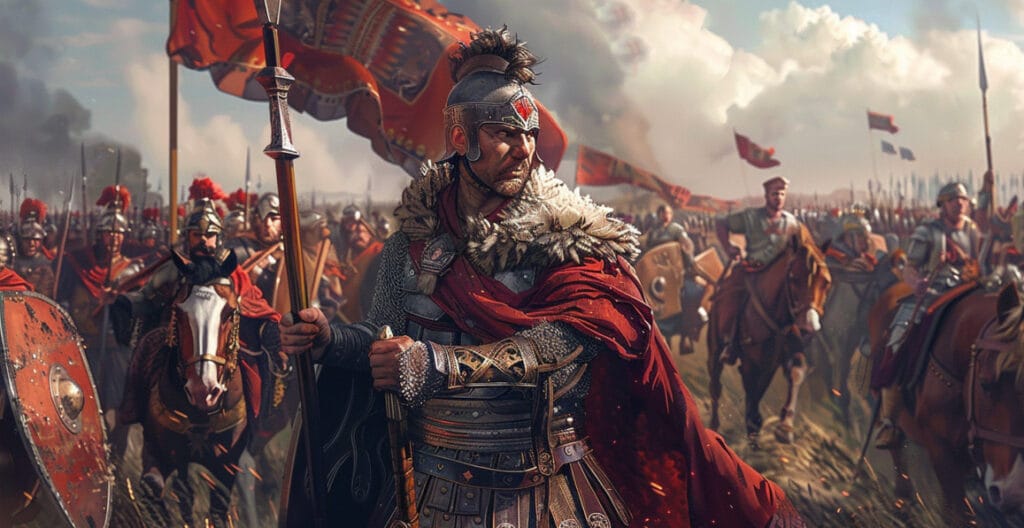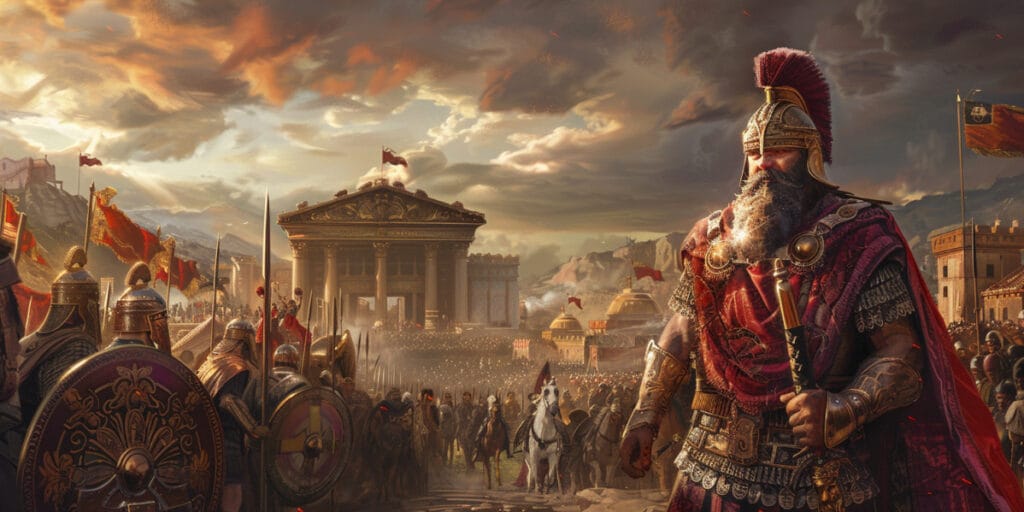
Period: AD 260 – 274
For a brief time, caused by the weakened state of the empire, the western provinces managed to break away from Rome, creating their own independent state, known as the Gallic empire.
Marcus Cassianius Latinius Postumus
Reign: AD 260 – 269
Marcus Cassianius Latinius Postumus probably was a Gaul (from the tribe of the Batavians), though his age and birthplace are unknown. When emperor Valerian was captured by the Persians, leaving his son Gallienus to struggle on alone, his time had come.
As governor Ingenuus and then Regalianus staged unsuccessful revolts in Pannonia, this took the emperor to the Danube, leaving Postumus, who was governor of Upper and Lower Germany, in charge at the Rhine.
Although the imperial heir Saloninus and the praetorian prefect Silvanus stayed behind on the Rhine at Colonia Agrippina (Cologne), to keep the young heir away from the danger of the Danubian revolts and perhaps also to keep an eye on Postumus.
Postumus’ confidence grew as he successfully dealt with German raiding parties and it wasn’t long before he fell out with Silvanus. With emperor Gallienus still occupied with the Danubian revolt, Postumus moved on Colonia Agrippina and forced its surrender. The prefect Silvanus and Saloninus, by now declared Augustus in a vain effort to intimidate Postumus, were put to death.
Postumus now declared himself emperor and was recognized not only by his own German troops but so too by those of Gaul, Spain and Britain – even the province of Raetia sided with him.
The new emperor set up a new Roman state, completely independent from Rome, with its own senate, two annually elected consuls and its own praetorian guard based at their capital of Augusta Trevivorum (Trier). Postumus himself should hold the office of consul five times.
However confident, Postumus realized he needed to tread carefully in his relations with Rome itself. He vowed not to spill any Roman blood and that would not lay claim to any other territory of the Roman empire. Postumus declared his sole intention was to protect Gaul – the very task emperor Gallienus had originally given him.
He did in fact in AD 261, as though to prove that point, drive back the Franks and Alemanni who had crossed the Rhine.
In AD 263 however, the Agri Decumates, the lands beyond the upper reaches of the Rhine and Danube were abandoned to the barbarians.
Gallienus though could hardly let such a great part of his empire break away unchallenged. In AD 263 he forced his way across the Alps and drove deep into Gaul. For some time Postumus managed to avoid a pitched battle, but alas he was defeated twice and retired into a fortified town determined to hold out. There a stroke of luck for Postumus saw to it that Gallienus, whilst besieging the town, was hit by an arrow in the back. Severely wounded the emperor had to break off the campaign, leaving Postumus the undisputed ruler of his Gallic empire.
In AD 268 in a surprise move, general Aureolus based in Mediolanum (Milan) openly changed sides to Postumus, while Gallienus was on the Danube.
Postumus own attitude toward this sudden turn of events is not known. In any case he failed to support Aureolus in any way, one the general was besieged by Gallienus at Mediolanum. This failure to seize the opportunity offered by Aureolus may well have lost Postumus some support among his followers.
Within the following year (AD 269), possibly due to dissatisfaction about Aureolus’ rebellion, Postumus needed to deal with a rebel on his own side who rose up against him on the Rhine. This rebel was Laelianus, one of Postumus’ most senior military leaders, who was hailed emperor at Moguntiacum (Mainz) by the local garrison as well as by other troops of the area.
Postumus was close by, at Augusta Trevivorum, and acted immediately. Moguntiacum was besieged and taken. Laelianus was put to death. Then however he lost control of his own troops. After taking Moguntiacum they sought to sack it. But the city being one of his own territory, Postumus would not allow it.
Enraged and out of control, the troops turned on their own emperor and killed him.
Marius

reign: AD 269
At Postumus death the Spanish provinces immediately changed sides back to Rome again.
The so reduced remains of the Gallic empire were inherited by the unlikely figure of Marius. He is said to have been a simple blacksmith and was most likely a common soldier (perhaps an army blacksmith?), elevated to power by his comrades at the sack of Moguntiacum (Mainz). The precise length of his rule is unknown. Some records suggest only 2 days, but it is likely he enjoyed imperial power for about two or three months. In any case, by the summer or autumn of AD 269 he was dead, strangled due to private quarrel.
Marcus Piaonius Victorinus
reign: AD 269 – 271
The next man to take up the post of ‘Gallic Emperor’ was Victorinus. This able military leader had been a tribune in the praetorian guard and by many been seen as the natural successor to Postumus.
However Rome was by now on the rise again and subsequently the Gallic empire was looking ever more shaky next to the increasing Roman might.
The Roman emperor Claudius II Gothicus in AD 269 simply seized control of territory east of the river Rhône without any significant resistance. Also all of the Hispanic peninsula returned back to Roman control in AD 269. Seeing their rulers weakened, the Gallic tribe of the Aedui now revolted and was only defeated by autumn AD 270, their final stronghold being finally overcome after seven months of siege.
His state shaken by such crisis, Victorinus was also a persistent womanizer. Rumours told of him seducing, possibly even raping, wives of his officials and entourage. And so it was perhaps only a matter of time until someone acted against Victorinus.
In early AD 271 Victorinus was killed, after one of his officials learnt that the emperor had propositioned his wife.
Domitianus
reign: AD 271
The man who saw to the murder of Victorinus was the virtually unknown Domitianus. Though his reign was very brief. Soon after his ascent to power he was overthrown by Tetricus with the support of Victorinus’ mother. After the fall of the Gallic Empire Domitianus was punished for treason by emperor Aurelian.
Tetricus

reign: AD 271 – 274
After the murder of Victorinus it was his mother, Victoria, who took it upon herself to announce a new ruler, despite the rise of Domitianus. Her choice fell on the governor of Aquitania, Tetricus.
This new emperor came from one of the leading families of Gaul and might well have been a relative of Victoria. But – more importantly in a time of crisis – he was popular.
Tetricus was hailed emperor at Burdigala (Bordeaux) in Aquitania in spring AD 271.
How exactly Domitianus was overthrown is unknown.
Before Tetricus even could reach the imperial capital Augusta Trevirorum (Trier) he needed to fend off a German invasion. In AD 272 again he was on the Rhine fighting off the Germans. His victories established him beyond doubt as an able military commander. In AD 273 his son, also Tetricus, was elevated to the rank of Caesar (junior emperor), marking him out as the future heir to the throne.
Finally, in early AD 274 emperor Aurelian, having defeated the Palmyrene empire in the east, now sought to reunite all the empire and marched against the Gallic empire. In a close battle on the Campi Catalaunii (Châlons-sur-Marne) Aurelian gained victory and restored the territories back to his empire. Tetricus and his son surrendered.
The circumstances surrounding the end of the Gallic empire though are shrouded in mystery. The ruthless Aurelian did not have Tetricus executed but far more rewarded him with the post of governor of Lucania, where he shoudl peacefully live to a ripe old age. Also the young Tetricus, who had been Caesar and heir to the Gallic empire, was not killed but granted senatorial rank.
There are suggestions of agreements between Tetricus and Aurelian prior to the battle taking place.
There are even rumours that Tetricus had invited Aurelian’s invasion, in order to save himself from falling victim to political intrigue at his own court.

Historian Franco Cavazzi dedicated hundreds of hours of his life to creating this website, roman-empire.net as a trove of educational material on this fascinating period of history. His work has been cited in a number of textbooks on the Roman Empire and mentioned on numerous publications such as the New York Times, PBS, The Guardian, and many more.
